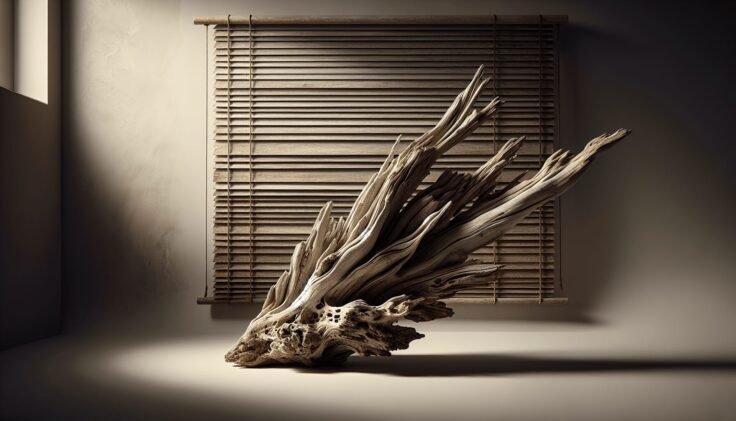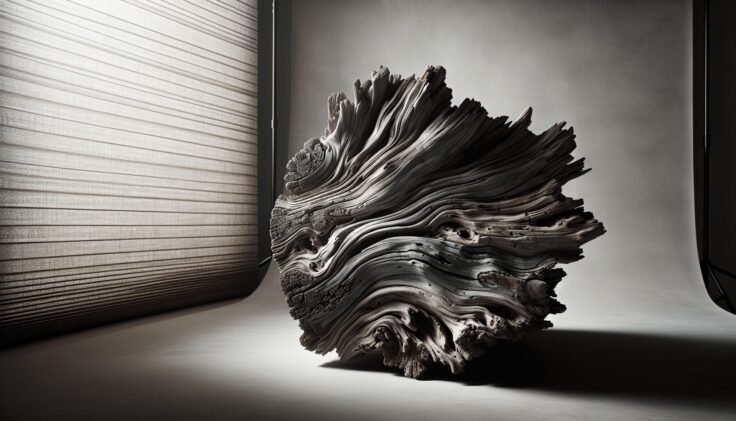Have you ever considered how much your window coverings say about your style and taste? Often overlooked, window blinds can significantly alter the ambiance of a room, offering more than just functionality. If you’ve come across the term “driftwood blinds” and are curious about what makes them unique, you’re in the right place. This guide will introduce you to the world of driftwood blinds and how they can transform your living space.

What Are Driftwood Blinds?
Driftwood blinds are a type of window covering made to resemble or incorporate actual driftwood. With a rustic, natural appearance, these blinds add a touch of the outdoors to your indoor environment. Inspired by the naturally weathered and textured look of driftwood found along shorelines, they provide a distinct and unpolished charm to any room.
The Appeal of Driftwood Aesthetics
Driftwood carries an inherent beauty that reflects a journey of time and nature. Each piece tells a story of its origin, from mighty forests into the ocean depths, finally arriving ashore after being sculpted by water and wind. The uniqueness of each piece makes a driftwood aesthetic desirable for those seeking a connection to nature and non-conventional décor.
Why Choose Driftwood Blinds?
Choosing driftwood blinds is less about following trends and more about embracing an enduring style. These blinds are perfect for anyone wanting to incorporate an organic element in their home that speaks of a sustainable and conscious lifestyle. They’re not just eye-catching but also versatile, fitting various home decor styles from rustic to modern coastal.
Materials Used in Driftwood Blinds
While the term suggests that these blinds are made entirely from driftwood, that’s not necessarily the case. Instead, they are crafted using materials that mimic the look and texture of driftwood, often enhanced by finishes and treatments to enhance durability and aesthetic appeal.
Natural Wood Variants
Many driftwood blinds use natural wood variants, treated and stained to achieve the desired driftwood look. A variety of woods can be used, such as:
- Pine: Known for its light, soft wood, it absorbs stains well.
- Bamboo: Lightweight and durable, making it eco-friendly.
- Oak: Offers sturdiness and a rich texture.
Faux Driftwood Materials
For those concerned about sustainability or cost, faux materials are an excellent alternative. These materials might include composites or sustainable synthetic options that mimic driftwood’s appearance without the environmental impact.
Styles to Suit Every Room
Driftwood blinds are available in various styles that can cater to different tastes and functional needs.
Roll-Up Blinds
These are popular for their simplicity and ease of use. Roll-up driftwood blinds are typically lightweight, making them a great option for those who prefer a minimalist look. They are ideal for kitchens, bathrooms, or any room where ease of operation is key.
Venetian Blinds
Venetian blinds made from driftwood or its lookalike offer a classic approach with adjustable slats, allowing control over light and privacy. These blinds are versatile, working well in living rooms, bedrooms, or home offices where you may need variable lighting throughout the day.
Roman Blinds
If you prefer something more decorative, driftwood-style Roman blinds can offer a sophisticated layer to your window décor. When pulled up, they fold into soft pleats that add texture and depth. This style is perfect for those who want elegance in rooms like dining areas or lounges.
Shutters
For a more permanent fixture, consider driftwood shutters. They provide excellent insulation and privacy control while serving as a stunning architectural feature. Ideal for large windows or spaces where you want to make a bold statement.
Incorporating Driftwood Blinds in Your Home Decor
Now that you understand the basics, let’s explore how you can integrate driftwood blinds into your living spaces.
Complementing Your Interiors
The neutral and earthy tones of driftwood blinds complement a broad color palette. Whether your home features a coastal theme with light blues and whites or a more rustic setting with deep, rich hues, these blinds can harmonize well.
Coastal Styles
To achieve a coastal look, pair driftwood blinds with light-colored walls and natural accessories like seashells or coral decor. Add textures with wicker furniture or linen throws to maintain a beachy vibe.
Rustic Styles
For a rustic aesthetic, incorporate wooden beams, stone elements, and leather furnishings. Driftwood blinds will underline these natural elements, adding warmth and organic touch to the space.
Layering with Other Window Treatments
Driftwood blinds can be layered with other window treatments for added style and functionality. Curtains, valances, and sheers can bring softness or color while also offering additional light-blocking when needed.
Practical Benefits of Driftwood Blinds
Beyond aesthetics, choosing driftwood blinds offers several practical benefits.
Light Control and Privacy
Driftwood blinds, especially in Venetian or shutter styles, allow for precise control over light entry and privacy levels. You can easily adjust the angle of the slats or louvers to let in just the right amount of sunlight or to keep prying eyes out.
Energy Efficiency
When it comes to energy efficiency, driftwood blinds can also play a role in insulating your home. Properly fitted, they can help maintain indoor temperatures, keeping your home cooler in the summer and warmer in the winter.
Easy Maintenance
Like most wooden or faux-wood window treatments, driftwood blinds are relatively easy to maintain. Regular dusting with a soft cloth will keep them clean, while deeper cleans can be done with mild soapy water depending on the material used.
Measuring and Installing Driftwood Blinds
Ensuring a perfect fit is key to the performance and look of your driftwood blinds.
Measuring Tips
- Width: Measure the exact width of the window opening from left to right.
- Height: Measure from the top to the bottom within the window frame.
When ordering, specify whether these measurements are for inside or outside mount blinds to ensure accuracy.
Installation Guide
Installation can either be a DIY project or handled by professionals. Here’s a brief overview if you plan to tackle it yourself:
- Gather Tools: Philips screwdriver, level, measuring tape, pencil.
- Mark Your Mounting Points: Whether inside or outside mount, mark where brackets will attach.
- Install Brackets: Secure brackets as per the marks, ensuring they’re level.
- Attach Blinds: Fit the headrail into the brackets, and ensure it’s secure.
- Test: Open and close the blinds to verify smooth operation.

Cost Considerations
The cost of driftwood blinds can vary widely based on material, size, and brand.
Real Wood Versus Faux Materials
Real wood blinds will typically cost more due to their natural material and processing involved. Faux options might offer a more budget-friendly alternative while still capturing the essence of driftwood.
Custom Versus Ready-Made
Custom blinds are tailored to your exact specifications, providing a perfect fit and unique style, but they come at a higher price point. Ready-made plans are more economical and can be an excellent choice if you have standard window sizes.
Caring for Your Driftwood Blinds
To preserve both the look and functionality of your driftwood blinds, regular care is essential. Here’s how to keep them looking their best:
Routine Cleaning
- Dust Regularly: Use a microfiber cloth or feather duster.
- Spot Clean: Use a slightly damp cloth for any spots or stains.
Deep Cleaning
- For more thorough cleaning, depending on the material, you might use wood cleaners for natural wood or gentle all-purpose cleaners for synthetic materials.
Maintenance Tips
- Humidity Control: Wood blinds can warp with too much moisture. Ensure proper ventilation in humid areas.
- Check for Damage: Periodically inspect blinds for any signs of wear or damage that might need fixing or replacement.
Enhancing Ambiance with Lighting and Decor
Driftwood blinds set a foundational tone, but don’t forget other elements that contribute to your room’s ambiance.
Lighting
Complement the rustic charm of driftwood blinds with soft lighting. Consider using table lamps with distressed wooden bases or pendant lights with a vintage finish to complete the look.
Accessories
Natural accessories such as potted plants, woven baskets, or jute rugs can enhance that serene, nature-inspired atmosphere. Small details like driftwood picture frames or coasters can further integrate this theme into your decor.
Paint Color Choices
To harmonize with driftwood blinds, opt for wall colors that evoke nature’s palette. This might include soft greens, creamy whites, and earthy browns, all of which can help reinforce the natural appeal.
Driftwood Blinds and Environmental Impact
An often-discussed topic nowadays is the environmental impact of home decor choices. Let’s explore how driftwood blinds fit into this conversation.
Sustainability of Materials
Natural wood blinds, particularly when sourced from sustainable forests or reclaimed wood, offer an eco-friendly option. Faux woods that utilize recycled materials are another excellent choice for the environmentally conscious.
Energy Savings
As mentioned, the insulating properties of well-fitted blinds can potentially reduce energy bills, making your home more energy-efficient.
Buying Tips: Finding the Right Driftwood Blinds
With so many choices, here are a few tips to find the perfect driftwood blinds for your home:
Prioritize Quality
Whether choosing real or faux options, look for reputable manufacturers known for durable, well-made products.
Consider Your Lifestyle
Think about how your window coverings will be used day-to-day. Homes with pets or children might fare better with more durable, easy-to-clean materials.
Sample Swatches
Many retailers offer sample swatches, allowing you to see and feel the material in your space before making a decision.
Budgeting
Set a clear budget before shopping, accounting for installation costs if you’re not planning to do it yourself.
Customizing Driftwood Blinds for Personal Style
Adding personal touches such as custom colors or unique finishes can make driftwood blinds even more suitable to your style.
Paint and Stain
If you’re up for a DIY endeavor, consider applying a custom paint or stain to achieve the exact look you’re after, ensuring it matches or complements your existing decor.
Decorative Add-Ons
Incorporate decorative pulls or valances that echo other design elements in your room. Small changes like these can have a substantial impact on your room’s overall look.
Conclusion
Driftwood blinds are more than just a way to cover your windows—they’re a means of bringing the beauty and tranquility of nature into your home. Offering a unique blend of aesthetics, functionality, and environmental consciousness, they are an excellent choice for anyone looking to enhance their living space in a thoughtful and stylish manner. Whether you’re decorating a beachside retreat or a countryside cottage, these versatile blinds can transform your room into a serene sanctuary, reflective of your personal taste and values. Choosing the right style, material, and finish allows you to capitalize on the rugged beauty of driftwood blinds, fostering an environment of comfort, beauty, and simplicity in your home.